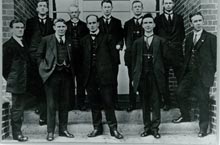Our history

Footscray Technical College
Victoria University (VU) was founded in 1916 as Footscray Technical School. After successive mergers with TAFE colleges across Melbourne's western suburbs, Victoria University of Technology was established in 1990, and renamed Victoria University in 2005.
Today, VU is one of the largest and most culturally diverse education institutions in Australia, and one of only five multi-sector universities offering vocational education (TAFE) and higher education courses.
VU now has more than 48,000 enrolled students, which includes more than 13,400 international students studying our courses onshore or with our partner institutions offshore. More than 2,400 academics, teaching and general staff join with the University’s students to make VU a university that is excellent, engaged and accessible.
VU maintains strong links with local communities, government and industry, and is distinctive because of its transformational role in improving the lives of people and communities, especially in the western metropolitan region of Melbourne.
On this page
Celebrating a centenary of opportunity in 2016
We are excited about celebrating our Centenary in 2016 with our students, staff, alumni, friends and partners locally and across the globe. We will also celebrate our 25th anniversary as a university.
The Centenary marks 100 years of the delivery of high quality, accessible education in the west of Melbourne. We’re very excited to be launching our full Program of Activity in August 2015, so be sure to check in to find out how you can get involved.
It’s a great time to reflect on our heritage and share our vision for the future as the University of opportunity.
Learn more about the history of VU and its predecessors by taking a virtual walk through The Door of Opportunity exhibition.
Transforming the west and beyond

First teachers in 1916
The idea for a technical school based in the western suburbs of Melbourne was first proposed in 1910. It was a time of great optimism when people believed in the power of technical knowledge to positively transform lives and social conditions. It took more than five years of hard work to raise funds to build the school, but in 1916 the Footscray Technical School finally opened its doors to 300 students and 16 teachers.
Charles Archibald Hoadley was the school's principal from its founding until his death in 1947. His vision was to develop students who had not only a sound technical knowledge but also an appreciation of the arts, sport, outdoor and community activities. He believed in educating students "for life as well as for living", and wanted students to view education as opening the doors of opportunity.
Under Hoadley's leadership, the school expanded rapidly and began offering trade certificate courses, diplomas in architecture, building and contracting, as well as evening classes. War and the depression saw a dip in numbers but by 1943 there were 2,500 students enrolled on courses taught at the Footscray Park and Footscray Nicholson Campuses.

Footscray Technical School Prospectus 1947-1948
The following decade saw a gender and cultural shift. Women first enrolled in the day diploma course in 1960, and changes to the Federal Government's immigration policy saw many more European and Asian names entered on the roll.
In 1958 the school changed its name to the Footscray Technical College. Ten years later it changed its name again, this time to Footscray Institute of Technology (FIT), and in 1972 the secondary school component was separated from the rest of the Institute.
By the mid 1970s, the expanded curriculum included degree courses and was well beyond the technical focus of the original Footscray Technical School.
Further changes occurred in the 1980s with the technical and trades education section separating from FIT to form the Footscray and Newport Colleges of TAFE.
In 1990, FIT merged with the Western Institute, which had been founded three years earlier to provide TAFE and higher education courses to the outlying suburbs in Melbourne's west. This led to the establishment of Victoria University of Technology (VUT). A further amalgamation occurred in 1998, this time with the Western Melbourne Institute of TAFE. In 2005 VUT was renamed Victoria University.
Naming VU
Victoria University was formed by a series of amalgamations with institutions across the west of Melbourne and has undergone several name changes.
VU's predecessor institutions include:
- Footscray Technical School renamed Footscray Technical College
- Footscray Institute of Technology
- Footscray College of TAFE
- Newport College of TAFE
- Gellibrand College of TAFE renamed Western Metropolitan College of TAFE
- Western Melbourne Institute of TAFE
- School of Painting, Decorating and Signcrafts
- Melbourne College of Decoration (Painting, Decorating and Signwriting Programs)
- Melbourne School of Hairdressing renamed Melbourne Technical College of Hairdressing
- Flagstaff College of TAFE
- Western Institute
Since the University was first formed in 1990 it has been known as:
- Victoria University of Technology
- Victoria University
You can explore more about the different institutions that came together to form VU on the VU Archives guide, or view the historical timeline which highlights key dates and events in VU's history.
VU Archives
In 1992, the University Council established VU Archives to be responsible for the care and management of any records created by Victoria University or its predecessors that were deemed to be "of permanent corporate, cultural or historical significance". The Archives now hold a vast range of items dating back to 1915, shortly before the opening of the Footscray Technical School. These include audio and video tapes, correspondence, committee minutes, photographs, clothing, prospectuses and handbooks, sporting memorabilia, graduation records and student newspapers.
VU Archives is located at the Footscray Park Campus. If you would like to know more you can email the University archives at records@vu.edu.au or view the guide to the VU Archives. The guide provides information about the scope of the archives collection, how to access the material in the archives and a history of VU and its predecessor institutions.
Into the future
In late 2013, Council endorsed a refreshed strategic plan, 2012-2016: Excellent, Engaged and Accessible: The University of Opportunity, which built upon the principles of the previous version.
Following on from this refreshed plan, Victoria University will be renowned for its three distinguishing features as:
- The University of Opportunity
- The University of Industry and Community
- Australia’s Sport University
Victoria University’s major ambition is to be an international leader in providing access to an excellent tertiary education to students from diverse backgrounds, to help them achieve true success, earning a reputation as the University of Opportunity. To become the University of Opportunity, Victoria University will prioritise:
- Delivery of a high-quality student experience with a focus on engaged teaching capabilities for work and life.
- Pathways to success through a distinctive Victoria University Tertiary Education Model with various entry and exit points, with course content and teaching methods aligned to student needs, both now and in their futures.
- Broad access programs to more selective programs in flagship areas, which distinguishes the Victoria University model of education from its competitors.
Victoria University is also aiming to be a ‘great university of the 21st century’. This challenges the traditional concept of greatness associated with institutions that focus on the academic elite. Victoria University’s aim is to provide excellent tertiary education to students from diverse countries, cultures, socioeconomic and educational backgrounds, and help them succeed. It cares about students finding their own true success, whether it is in their career choice or along their learning journey.
By the time Victoria University’s next strategic plan is prepared, the University expects to be an international leader in at least one of its ten focus industries, and in its three interdisciplinary themes of:
- Sport, health and active living
- Education, lifelong learning and workforce development
- Sustainable industries and liveable cities.
The refreshed strategic plan defines Victoria University's distinctiveness in the tertiary education sector, and provides a framework within which the University can design and implement specific strategies required to achieve the vision of being the University of Opportunity.
View the Strategic Plan 2012-2016: Excellent, Engaged and Accessible: The University of Opportunity.


